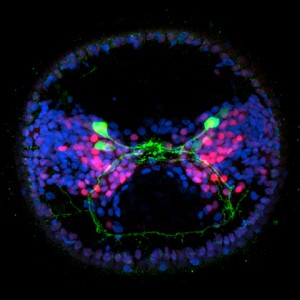Recruitment
We are looking for motivated undergraduate and graduate students interested in research. For more information, please email Néva Meyer.
Background
Welcome to the Meyer lab! Our lab strives to understand the genetic mechanisms controlling annelid development with a goal of learning more about evolution of animal body plans. One main focus is to understand evolution and development of nervous systems, which are an animal innovation. Nervous systems are complex, highly integrated animal organ systems capable of storing information (memory), sensing the environment, controlling behavior, and processing and integrating multiple types of information simultaneously. Multiple groups of animals throughout the Bilateria possess centralized nervous systems – vertebrates have an anterior brain and dorsal nerve cord, whereas annelids (segmented worms) and arthropods (insects and crustaceans) have an anterior brain and a ventral nerve cord. However, the earliest branching animals (e.g., comb jellies and jellies) have a neural plexus, or nerve nets. A centralized arrangement of neurons may allow for more sophisticated processing of information and thus, exploitation of new habitats and evolution of new lifestyles and body shapes. It has been hypothesized that a neural plexus evolved first, and there are differing hypotheses of when and how a CNS arose, ranging from one common origin to multiple, convergent origins. Our lab studies annelid development using classical embryological techniques, e.g., blastomere isolation and fate mapping, as well as modern genomic and molecular approaches, e.g., RNA sequencing and CRISPR-Cas9 gene editing. Our focus is to understand the molecular and cellular mechanisms underlying neural specification and neurogenesis in the annelid Capitella teleta and a few other annelids. We also have recently begun to study development and evolution of other annelid features including the ventral midline. To learn more about our research, visit the “Research” page above.
Picture credit: François Michonneau
Teaching
I teach a course in Neuroscience (BIOL 143), lab courses in Developmental Biology (BIOL 221/321) and Comparative and Human Physiology (BIOL 240/340), and a seminar course in EvoDevo (Biol239/339). BIOL 143 is an introduction to neuroscience that explores the biology of nervous systems and their relationship to behavior and disease. BIOL 221 focuses on the processes by which a fertilized egg gives rise to a multicellular animal with organs, tissues, and cell types that are structurally and functionally distinct and are arranged in a characteristic three-dimensional body plan. BIOL 240/340 is an introduction to the physical and chemical functions that maintain animal, including human, life. Finally, BIOL 239 covers a broad range of topics in evolutionary developmental biology, or “evodevo”, which focuses on how changes in developmental processes have given rise to the incredible biological diversity seen in nature.



